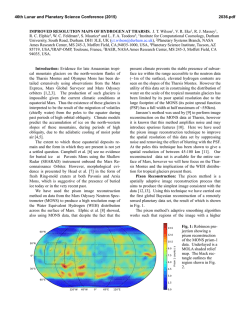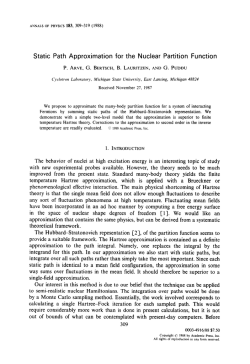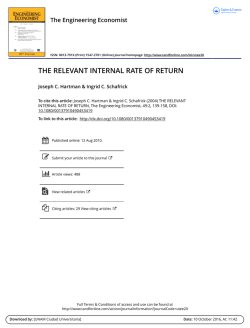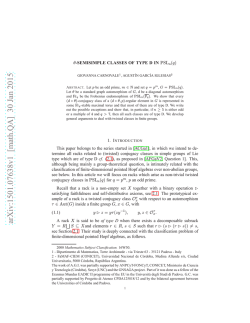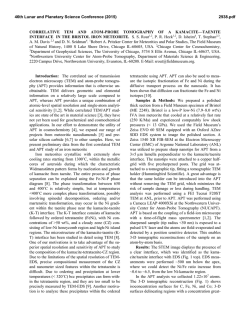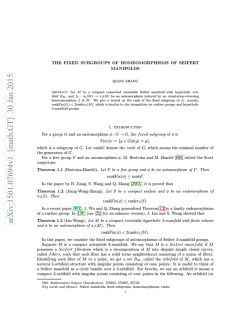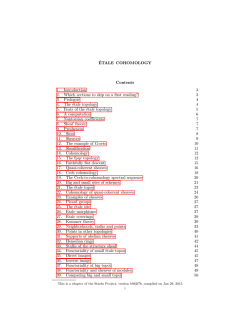
Efficient reconstruction of partitions
Discrete Mathematics 293 (2005) 205 – 211 www.elsevier.com/locate/disc Efficient reconstruction of partitions Philip Maynard1 , Johannes Siemons School of Mathematics, University of East Anglia, Norwich NR4 7TJ, UK Received 2 July 2003; received in revised form 10 May 2004; accepted 18 August 2004 Available online 31 March 2005 Abstract We consider the problem of reconstructing a partition x of the integer n from the set of its tsubpartitions. These are the partitions of the integer n − t obtained by deleting a total of t from the parts of x in all possible ways. It was shown (in a forthcoming paper) that all partitions of n can be reconstructed from t-subpartitions if n is sufficiently large in relation to t. In this paper we deal with efficient reconstruction, in the following sense: if all partitions of n are t − -reconstructible, what is the minimum number N = N − (n, t) such that every partition of n can be identified from any N + 1 distinct subpartitions? We determine the function N − (n, t) and describe the corresponding algorithm for reconstruction. Superpartitions may be defined in a similar fashion and we determine also the maximum number N + (n, t) of t-superpartitions common to two distinct partitions of n. © 2005 Elsevier B.V. All rights reserved. Keywords: Reconstruction; Partitions 1. Introduction Let P(n) denote the set of all partitions of the integer n. Thus, if x ∈ P(n) then x = [x1 , x2 , . . . , xl ] is a multiset of integers xi with 0 xi and li=1 xi =n. To avoid cumbersome distinctions we identify two partitions if they differ by parts of size 0 only. If x ∈ P(n) and if t is an integer with 0 t n then l we say that x := [x1 − e1 , x2 − e2 , . . . , xl − el ] is a t-subpartition if 0 ei xi and i=1 ei = t. E-mail address: [email protected] (J. Siemons). 1 The author acknowledges financial support through the project on Reconstruction Indices funded by the Leverhulme foundation. 0012-365X/$ - see front matter © 2005 Elsevier B.V. All rights reserved. doi:10.1016/j.disc.2004.08.037 206 P. Maynard, J. Siemons / Discrete Mathematics 293 (2005) 205 – 211 The set of all t-subpartitions of x is denoted by Dt (x) and we say that x is reconstructible from its t-subpartitions, or that x is t − -reconstructible, if and only if the following is true: Whenever Dt (x) = Dt (y) for some y ∈ P(n), then x = y. For instance, x = [3, 2, 2, 1] has D2 (x) = {[3, 2, 1], [3, 1, 1, 1], [2, 2, 2], [2, 2, 1, 1]} and by elementary arguments one can show that x is 2− -reconstructible. On the other hand, D5 (x) = {[3], [2, 1], [1, 1, 1]} = D5 ([5, 2, 1]) and so x is not 5− -reconstructible. Note also that in contrast to other reconstruction problems here we have no information about the multiplicity with which a partition occurs in Dt (x). The problem of reconstructing partitions was proposed in [4,1]. Intuitively, if t is small in relation to n then the partitions of n should be t − -reconstructible, and this is proved in [5]. In this paper we deal with an additional issue: if all partitions of n are t − -reconstructible, is there an N = N − (n, t) such that an arbitrary x ∈ P(n) can be identified from any N + 1 distinct members of Dt (x)? This is the problem of efficient reconstruction first considered in Levenshtein’s seminal paper [2] on the reconstruction of sequences. Here we also answer the question of efficient reconstruction of partitions. To state these results we need some additional definitions. If x = [x1 , x2 , . . . , xl ] ∈ P(n) and if 0 t and 0 e1 , e2 , . . . , el are integers with l l and li=i ei = t then x = [x1 + e1 , x2 + e2 , . . . , xl + el , el+1 , . . . , el ] is a t-superpartition of x. The set of all t-superpartitions of x is denoted by Ut (x). The partition x is said to be reconstructible from its t-superpartitions, or t + -reconstructible, if and only if the following is true: whenever Ut (x) = Ut (y) for some y ∈ P(n) then x = y. For n t 0 we define N − (n, t) := max x,y∈P(n); x=y |Dt (x) ∩ Dt (y)| and D(n, t) := max |Dt (x)|, x∈P(n) and for arbitrary t 0 we define N + (n, t) := max x,y∈P(n); x=y |Ut (x) ∩ Ut (y)| , U (n, t) := max |Ut (x)|. x∈P(n) Clearly, N − (n, t) D(n, t) and N + (n, t) U (n, t), and if x ∈ P(n) satisfies N − (n, t) < |Dt (x)| then x is t − -reconstructible. In fact, the function N − (n, t) measures efficient reconstructibility in the sense that for an arbitrary partition x ∈ P(n) any N − (n, t) + 1 or more distinct members of Dt (x) determine x uniquely, as intended above. A similar statement holds for N + (n, t) and t + -reconstructibility. Theorem 1.1. Let n 2 and t 1. Then N − (n, t)=D(n−1, t −1) for n t and N + (n, t)= U (n + 1, t − 1) for all t. This theorem is the exact analogue of the main result of Levenshtein in [2] on the efficient reconstruction of a sequence from its sub- and supersequences. In particular, every partition x ∈ P(n) is reconstructible from any two of its 1-subpartitions, as D(n − 1, t − 1) = 1 for t = 1. In Section 2 it is shown that D(n, t) = |P(n − t)| for some values of n and t. P. Maynard, J. Siemons / Discrete Mathematics 293 (2005) 205 – 211 207 In the same sections we obtain the proof of the theorem above and we give algorithms to reconstruct the partitions in each case. We may regard partitions as Young diagrams and hence as elements of the Young lattice. In this lattice the set of elements of rank n is P(n), see [6, Chapter 7] for instance, and for x ∈ P(n) the set D1 (x) are the partitions which appear in the Murnaghan–Nakayama rule. Therefore, partition reconstruction can be placed into the larger context of reconstruction problems in lattices. In a recent paper Stanley [7] determines the number of standard Young diagrams of n + t cells which contain a given partition of n. It may well be possible to use these techniques to give formulae for the values of D(n, t) and U (n, t) in general. One further general comment should be made. As we have seen, partitions and sequences both belong to a class of reconstruction problems where reconstruction is guaranteed, and where even the problem of efficient reconstruction has a satisfactory answer. One may therefore ask which other kinds of reconstruction problems belong to that class. For orbit reconstruction of permutation groups we know that also cyclic, and possibly solvable groups belong to this class. In [3] we consider the reconstruction problems associated with finite primitive groups. In this generality efficient reconstruction cannot be expected any longer. 2. Subpartition reconstruction If x ∈ P(n) is a partition, we shall always assume that x is in standard form x = [x1 , x2 , . . . , xl ] with xi xi+1 for i = 1, 2, . . . , l − 1. Also, we let x := 1 i l xi be the number partitioned by x. If also y =[y1 , y2 , . . . , ym ] is a partition, possibly of a different integer, the intersection x ∩ y is the partition x ∩ y = [min{x1 , y1 }, min{x2 , y2 }, . . . , min{xv , yv }], where v = min{l, m}. Similarly, the union x ∪ y is the partition x ∪ y = [max{x1 , y1 }, max{x2 , y2 }, . . . , max{xw , yw }], where w = max{l, m} and where we assume that xl = 0 for l > l and ym = 0 for m > m. These definitions make sense since we are assuming that our partitions are in standard form. Note that then also x ∪ y and x ∩ y are in standard form and further that x ∩ y = x if and only if x ∪ y = y. We can now define a partial order on partitions by x⊆y if and only if x ∩ y = x. For any integer m > 0 we define the partition S(m) := [m, m/2, m/3, . . . m/(m − 2), m/(m − 1), 1] of s(m) := m i=1 m/ i. It is easy to see that for any u ∈ P(m) there exist subpartitions of S(m) that are equal to u and S(m) is the smallest partition with this property. That is to say, if x is a partition of some integer m < s(m) then there are partitions u ∈ P(m) which are not subpartitions of x. We can now prove Lemma 2.1. Let x be a partition of n. Then x ∩ S(n − t) determines Dt (x) uniquely. That is, if x and y ∈ P(n) then Dt (x) = Dt (y) if and only if x ∩ S(n − t) = y ∩ S(n − t). 208 P. Maynard, J. Siemons / Discrete Mathematics 293 (2005) 205 – 211 Proof. First we prove that if x ∩ S(n − t) = y ∩ S(n − t) then Dt (x) = Dt (y). It is sufficient to show that if x ∩ S(n − t) = u then Dt (x) = Dr (u), where r = u + t − n. Certainly, Dr (u) ⊆ Dt (x). Thus, assume that there is some z ∈ Dt (x) with z ∈ / Dr (u). However, then we would have z ∩ S(n − t) = z for some z ∈ P(n − t), a contradiction. Next assume that x ∩ S(n − t) = y ∩ S(n − t). Let x ∩ S(t) = S = [s1 , s2 , . . . , sl ] and y ∩ S(t) = T = [t1 , t2 , . . . , tl ] for some l, l ∈ N. Let the first instance of inequality of these sequences be, without loss, si > ti for some i ∈ {1, 2, . . . , min{l, l }}. Consider the partition u=[si , si , . . . , si ] of the integer is i . Now si (n−t)/ i and so u i(n−t)/ i n−t. / Dt (y). Therefore there is some v ∈ Dt (x) such that u ∩ v = u. It is clear that v ∈ We can use Lemma 2.1 to manufacture non-reconstructible partitions: take x, y ∈ P(n) with x = y and x ∩ S(m) = y ∩ S(m) for some m ∈ N. Then Dn−m (x) = Dn−m (y) and so x and y are not reconstructible from their (n − m)-subpartitions. For example, take the partition S(m) for any m ∈ N and consider x, y ∈ Ui (S(m)), different partitions of the integer s(m)+i for any i ∈ N. By Lemma 2.1 we have Dv (x)=Dv (y)=Du (S(m))= P(m) where u = s(m) − m and v = u + i. Next we need the following simple lemma. Lemma 2.2. For any n, t, i ∈ N with n t we have D(n, t) D(n+i, t +i). Furthermore, for any n, t, i ∈ N with 1 i < n we have U (n, t) < U (n − i, t + i). Proof. Assume that y ∈ P(n). For the first inequality observe that Dt (y) ⊆ Dt+i (x) for any x ∈ Ui (y) for any i ∈ N. This implies that D(n, t) D(n + i, t + i). Secondly, for 1 i < n we have Ut (y) ⊂ Ut+i (x) for any x ∈ Di (y) and so U (n, t) < U (n − i, t + i). We note that in general we cannot have strict inequality in the first inequality. Indeed, it follows from Lemma 2.1 that D(n, t) = D(n + i, t + i) = |P(n − t)| for any i ∈ N, if n s(n − t). Theorem 2.3. If n 2 and n t 1, then N − (n, t) = D(n − 1, t − 1). Furthermore, there exist partitions x and y of n such that D1 (x) ∩ D1 (y) consists of a single partition z of n − 1 for which |Dt−1 (z)| = N − (n, t). Proof. First we show that N − (n, t) D(n − 1, t − 1). Let z be a partition of n − 1 corresponding to D(n − 1, t − 1), i.e., |Dt−1 (z)| is maximal among the partitions of n − 1. We note that for any 1 m ∈ N and p ∈ P(m) we have |U1 (p)| 2. Thus let x, y ∈ U1 (z) with x = y. Certainly Dt−1 (z) ⊆ Dt (x), Dt (y) and hence it follows that N − (n, t) |Dt (x) ∩ Dt (y)| |Dt−1 (z)| = D(n − 1, t − 1). (1) Next we show that N − (n, t) D(n − 1, t − 1). Thus assume that x, y ∈ P(n), x = y are such that |Dt (x) ∩ Dt (y)| is maximal. Set w := x ∩ y. Then Dt (x) ∩ Dt (y) ⊆ Dv (w), P. Maynard, J. Siemons / Discrete Mathematics 293 (2005) 205 – 211 209 where v = x ∩ y + t − n. In particular, |Dt (x) ∩ Dt (y)| |Dv (w)| D(x ∩ y, v) D(n − 1, t − 1). The last inequality following from Lemma 2.2 upon taking i = n − 1 − x ∩ y. To prove the final part we consider again the partitions x, y constructed at the beginning of the proof. It now follows that the inequalities of (1) are actually equalities and |Dt (x) ∩ Dt (y)| = |Dt−1 (z)| = D(n − 1, t − 1). In particular, for any x ∈ P(n) it follows that if |Dt (x)| D(n − 1, t − 1) + 1 then x is reconstructible from its t-subpartitions. Corollary 2.4. Any two different 1-subpartitions of a partition allow its reconstruction. All partitions of n 3 are reconstructible from their 1-subpartitions. Proof. Taking t = 1 in Theorem 2.3 we get N − (n, 1) = D(n − 1, 0) = 1. This proves the first statement. For the second, note that the only partitions of n that have only one different type of 1-subpartition are xl = [l, l, l, . . . , l] ∈ P(n) for any l | n. For n 3 it is not hard to see that D1 (xi ) = D1 (xj ) for any i, j | n with i = j . For n = 2 the two partitions of 2 given by [1, 1] and [2] clearly have the same 1-subpartitions, hence the restriction. Algorithm for recovering a partition from its subpartitions. The following simple procedure reconstructs a partition x ∈ P(n) if one knows n and at least N − (n, t) + 1 members from the set Dt (x). (i) Take any y1 , y2 , . . . , yl ∈ Dt (x), where l = N − (n, t) + 1 and put them in standard form. (ii) Form the union x = i=1,...,l yi . We claim that x =x, as follows. Since allpartitions are in standard form, we have that yi ⊆ x and so i=1,...,l yi ⊆ x. Assume that i=1,...,l yi = x ⊂ x with, say, x = n < n. By Theorem 2.3 and Lemma 2.2 it follows that l > D(n−1, t −1) D(n , n +t −n) |Dv (x )|, where v =n +t −n. Conversely, since yi ⊆ x for i =1, 2, . . . , l it follows that |Dv (x )| l, a contradiction. No explicit formula for D(n, t) seems to be known for general n and t. For t = 1 and x =[x1 , x2 , . . . , xl ] it is easy to see that |D1 (x)| is the number of distinct xi , that is |D1 (x)|= |{x1 , x2 , . . . , xl }|. Thus N − (n, 1) is the greatest integer j for which j (j + 1)/2 n. Already for t = 2 it is much more difficult to give an explicit value for D(n, t). 3. Superpartition reconstruction In contrast to reconstruction from subpartitions, partitions are always reconstructible from superpartitions. 210 P. Maynard, J. Siemons / Discrete Mathematics 293 (2005) 205 – 211 Lemma 3.1. Every partition is reconstructible from its t-superpartitions, for any t ∈ N. In fact, if t is given, then just one suitably chosen member from Ut (x) allows the unique reconstruction of x. If t is not given then just two suitably chosen members from Ut (x) suffice to reconstruct x uniquely. Proof. Assume that x ∈ P(n) and without loss that n 2 since |P(1)|=1. If t is known, select q =[q1 , q2 , . . . , qr ] ∈ Ut (x) with the property that q1 > p1 for any p=[p1 , p2 , . . . , pr ] ∈ Ut (x) with p = q. It is clear then that x = [(q1 − t), q2 , . . . , qr ]. To determine t we select in addition the (unique) partition in Ut (x) which has the largest number of parts. If this number is l then clearly t = l − r. This completes the proof. The above lemma shows that for any x ∈ P(x) some two suitably chosen members from Ut (x) allows the reconstruction of x. The next theorem gives the minimum number of arbitrarily chosen members from Ut (x) needed to reconstruct x. Theorem 3.2. If n 2 and t 1 then N + (n, t) = U (n + 1, t − 1). Furthermore, there exist partitions x and y of n such that U1 (x) ∩ U1 (y) consists of a single partition z of n − 1 for which |Ut−1 (z)| = N + (n, t). Proof. First we show that N + (n, t) U (n + 1, t − 1). Thus let z ∈ P(n + 1) be a partition corresponding to U (n + 1, t − 1). Since n 2 there are at least two different 1-subpartitions of z unless possibly z = zv = [v, v, . . . , v] for any v | n. However, consider the partitions of n + 1 defined by wv = [v + 1, v, v, . . . , v, v − 1] for v < n and wn = [n, 1]. It is not hard to see that Um (wv ) Um (zv ) for any v | n and m ∈ N. In particular, we may assume that there exist x, y ∈ D1 (z) with x = y. Then we have Ut−1 (z) ⊆ Ut (x), Ut (y). Hence N + (n, t) |Ut (x) ∩ Ut (y)| |Ut−1 (z)| = U (n + 1, t − 1). (2) Next we prove that N + (n, t) U (n + 1, t − 1). So let x and y be distinct partitions of n such that |Ut (x) ∩ Ut (y)| is maximal. Clearly, any z ∈ Ut (x) ∩ Ut (y) must contain both x and y, i.e. p = (x ∪ y) ⊂ z. It follows that |Ut (x) ∩ Ut (y)| |Uv (p)|, where v = n + t − l and l = x ∪ y. In particular, N + (n, t) = |Ut (x) ∩ Ut (y)| |Uv (p)| U (l, n + t − l). Now if l > n+1, then by Lemma 2.2 it follows that N + (n, t) < U (n+1, t −1), in contradiction to the first part of the proof. It follows that l =n+1 and then N + (n, t) U (n+1, t −1). To prove the final part, we consider again the partitions x, y constructed at the beginning of the proof. It now follows that the inequalities of (2) are equalities and |Ut (x) ∩ Ut (y)| = |Ut−1 (z)| = U (n + 1, t − 1). Algorithm for recovering a partition from its superpartitions. The following simple procedure reconstructs a partition x ∈ P(n) if one knows n and at least N + (n, t) + 1 members from the set Ut (x). + (i) Take any y1 , y2 , . . . , yl ∈ U t (x) where l = N (n, t) + 1 and put them in standard form. (ii) Form the intersection x = i=1,...,l yi . P. Maynard, J. Siemons / Discrete Mathematics 293 (2005) 205 – 211 211 We claim that all partitions are in standard form we have that x ⊆ yi x =x, as follows. Since and so x ⊆ i=1,...,l yi . Assume that i=1,...,l yi = x with x ⊂ x . Say, x = n > n. By Theorem 3.2 and Lemma 2.2 it follows that l > U (n+1, t −1) U (n , n=n +t) |Uv (x )|, where v = n + t − n . On the other hand, since x ⊆ yi for i = 1, 2, . . . , l we also have that |Uv (x )| l, a contradiction. References [1] P. Cameron, Stories from the age of reconstruction, Congr. Numer. 113 (1996) 31–41. [2] V. Levenshtein, Efficient reconstruction of sequences from their subsequences and supersequences, J. Combin. Theory Ser. A 93 (2001) 310–332. [3] P. Maynard, J. Siemons, On the reconstruction of permutation groups: general bounds, A equationes Mathematicae, 2005, in press. [4] V. Mnukhin, Combinatorial Properties of Partially Ordered Sets and Group Actions, TEMPUS Lecture Notes: Discrete Mathematics and Applications, vol. 8, J. Siemons (Ed.), 1993. [5] O. Pretzel, J. Siemons, On the reconstruction of partitions and applications, to appear. [6] R.P. Stanley, Enumerative Combinatorics, vol. 2, Cambridge University Press, Cambridge, 1999. [7] R.P. Stanley, On the enumeration of skew Young tableaux, Adv. Appl. Math. 30 (2003) 283–294.
© Copyright 2025

